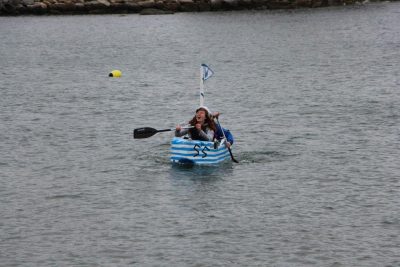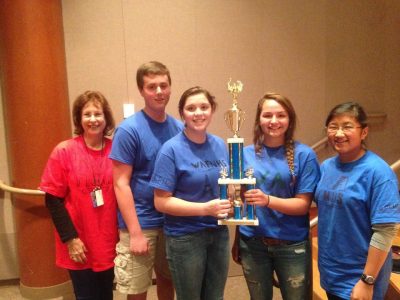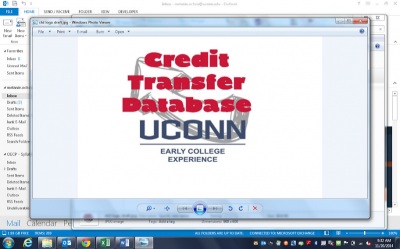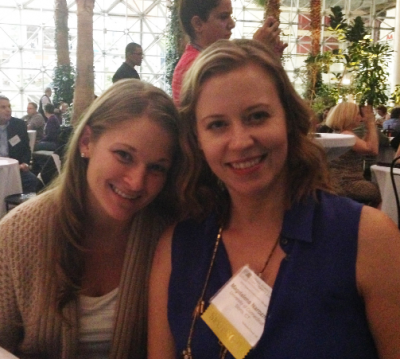by Gillian B. Thorne
2014 was an alphabet soup kind of year for UConn ECE! We were notified in April of our successful
reaccreditation in NACEP (National Alliance of Concurrent Enrollment Partnerships). Many of our instructors in the high schools helped up with our application by submitting required documentation we requested. UConn ECE will not face reaccreditation again until 2021. Our experience did, however, leave us with several important program improvement goals. Two primary goals that affect our partner high schools are (1) collection and archiving of UConn course syllabi, and (2) promoting clearer grading
standards coming from UConn departments for the courses that we offer.
In addition to providing important support for managing a standards-based concurrent enrollment program, NACEP organizes professional development and networking opportunities at the annual conference. The 2014 conference was held in the Windy City in late October. We were told we were lucky to have great weather, as Chicago does not always remain temperate at that time of year! Five of our UConn ECE staff members attended the conference. Each of us contributed to the conference as one or more of the following: session presenter, panel moderator, or session host. We all returned having made new professional contacts, and having learned and shared valuable information and ideas relating to concurrent enrollment.
During 2014, several of our staff members have been involved inorganizing and supporting the establishment of the first regional chapter of NACEP, which includes the six New England states, and is aptly called NEACEP (New England Alliance of Concurrent Enrollment Partnerships). While concurrent enrollment and NACEP have taken root and blossomed in most areas of the country, New England has been a latecomer to the table. UConn ECE has long promoted and encouraged NACEP standards and standards-based concurrent enrollment throughout New England by offering conferences and professional development opportunities. It is wonderful to see the development of NEACEP as a supportive professional development organization for concurrent enrollment.
The regional accreditation body for New England high schools and colleges, NEASC, also chose 2014 to establish standards for concurrent enrollment programs, although referred to as “dual” enrollment in the actual document. As has happened in other areas of the country at either the state or regional level, NEASC’s standards closely align with NACEP standards. UConn ECE welcomes the development of the NEASC standards; we believe that this is an important additional support for standards-based concurrent enrollment throughout New England and specifically in Connecticut.
Many of our partner high schools also have programs with a Connecticut community college structured similarly to concurrent enrollment, usually under College Career Pathways. UConn ECE’s Director Jill Thorne is a member of the Board of Regents’ Early College Steering Committee in Connecticut, and has been a part of the effort helping the community colleges to bring their programs in line with both NACEP and NEASC standards. Since this topic is likely to be of great interest to our partner high schools, UConn ECE plans to address this the day of our annual Site Representative Conference, in a companion session in the afternoon showcasing both the academic rigor of standards-based concurrent enrollment programs, and discussing how Connecticut’s concurrent enrollment programs’ staffs plan to collaborate at the high school level to help coordinate opportunities for students.
We look forward to seeing many of you at the conference, February 23rd. Together we will help you navigate the Alphabet Soup Sea!
























 nd the program invested in research to understand the program as a vital tool for student success [see article of transfer credit database Page 4]. Indeed, we are a national model for concurrent enrollment and are peers with other elite universities like Syracuse University, Indiana University, and the University of Washington. While the program has certainly grown and developed over the last 60 years, the core of the program has stayed the same. UConn ECE is dedicated to deep academic partnerships that provide access to and preparation for higher education at the high schools. We value our relationship with the departments and the high schools, and look forward to continued strength as we work together for student success.
nd the program invested in research to understand the program as a vital tool for student success [see article of transfer credit database Page 4]. Indeed, we are a national model for concurrent enrollment and are peers with other elite universities like Syracuse University, Indiana University, and the University of Washington. While the program has certainly grown and developed over the last 60 years, the core of the program has stayed the same. UConn ECE is dedicated to deep academic partnerships that provide access to and preparation for higher education at the high schools. We value our relationship with the departments and the high schools, and look forward to continued strength as we work together for student success.